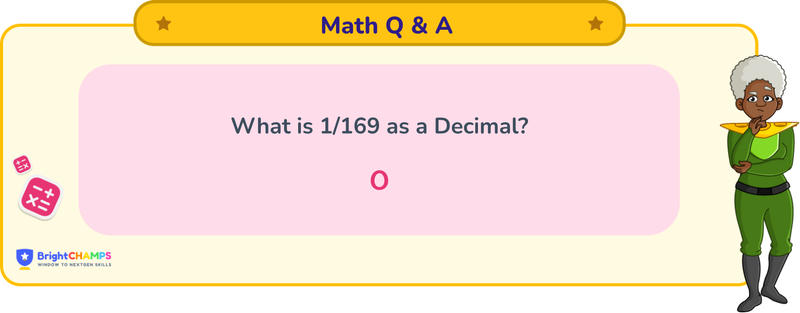
 156 Learners
156 LearnersLast updated on May 26th, 2025

1/169 as a Decimal

It is a simple question on decimal conversion. Firstly, we have to learn fractions and decimals. A fraction represents a part of the whole. It has two parts: the numerator (number on the top) here, 1, represents how many parts out of the whole. The denominator (number below) shows how many parts make the whole; here, it is 169. A decimal is a way to represent a number that is not whole, using a (.) or a decimal to separate the whole part from the fractional part. The numbers to the left of the decimal point represent the whole, and those to the right represent the fractional part.
What is 1/169 as a decimal?

Answer
1/169 in decimals can be written as 0.005917159763313609... It is a non-terminating decimal, showing it will not end or repeat the same pattern.
Explanation
To get 1/169 in decimal, we will use the division method. Here, as 1 is smaller than 169, we will take the help of the decimal method, which will give us approximately 0.005917159763313609. Let's see the step-by-step breakdown of the process:
Step 1: Identify the numerator and denominator because the numerator (1) will be taken as the dividend, and the denominator (169) will be taken as the divisor.
Step 2: As 1 is smaller than 169, it can't be divided; here, we will take the help of decimals. We will add 0 to the dividend, which will make 1 as 10, and add a decimal point in the quotient place.
Step 3: Now that it is 10, we can bring down more zeros and continue the division process.
Step 4: Since 10 is still smaller than 169, we continue bringing down zeros until we get a number larger than 169.
Step 5: Once the number exceeds 169, we perform the division and continue this process. The division process continues, and we observe that the decimal does not terminate or repeat a simple pattern. This process results in a non-terminating decimal.
The answer for 1/169 as a decimal will be approximately 0.005917159763313609...
Important Glossaries for 1/169 as a decimal
- Fraction: A numerical quantity that is not a whole number, representing a part of a whole.
- Decimal: A number that uses the base ten and includes a decimal point to separate the whole part from the fractional part.
- Numerator: The top part of a fraction, indicating how many parts of the whole are being considered.
- Denominator: The bottom part of a fraction, showing how many parts make up a whole.
- Non-Terminating Decimal: A decimal that continues infinitely and does not end.




